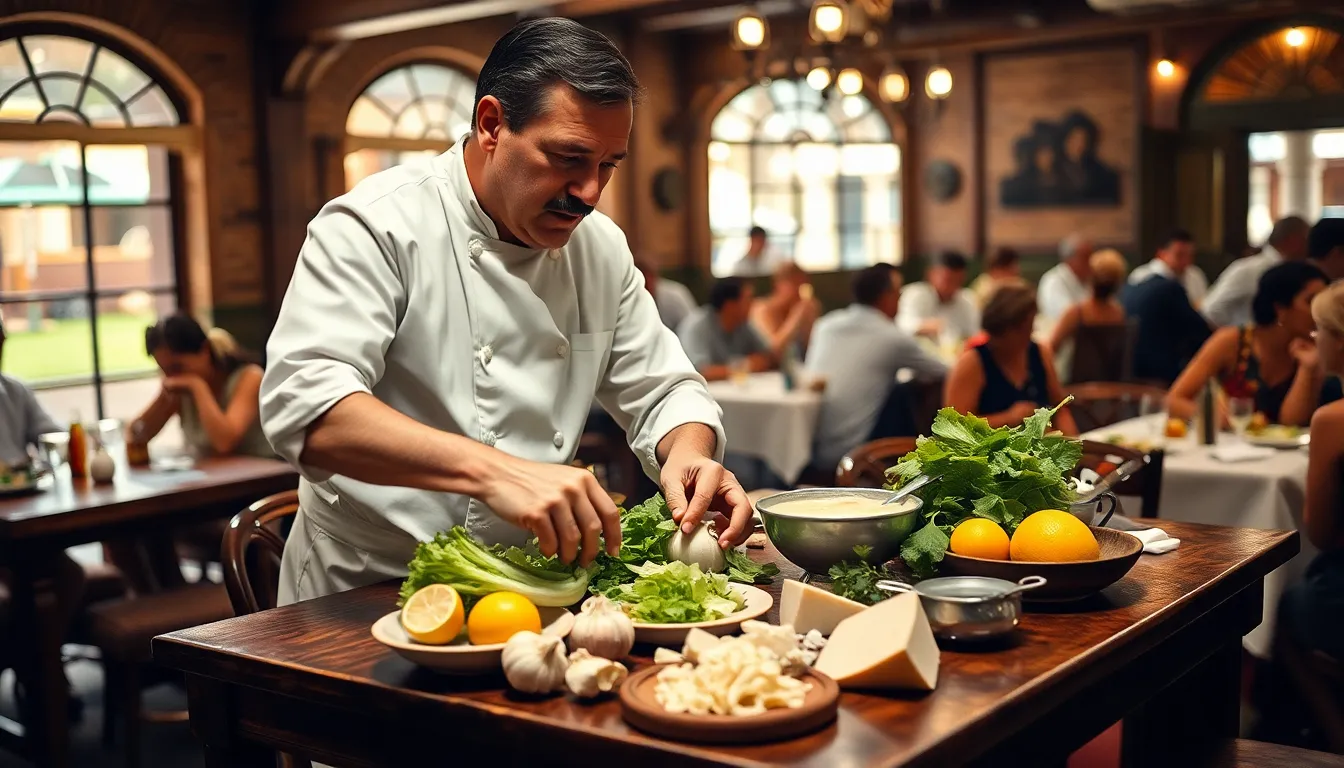Picture this: a bustling restaurant in Tijuana, Mexico, where culinary magic was about to unfold. The year was 1924, and a certain Caesar Cardini was whipping up something special that would forever change the salad game. But wait—before you toss those greens, let’s dive into the delicious mystery of where Caesar salad was truly born.
Table of Contents
ToggleThe Origins Of Caesar Salad
In a bustling Tijuana restaurant in 1924, Caesar Cardini crafted a dish that would become iconic. Cardini ran a popular eatery, attracting a diverse clientele, including Hollywood stars. He invented Caesar salad to address shortages during a busy weekend, utilizing ingredients on hand.
Romaine lettuce served as the base, complemented by a dressing combining olive oil, garlic, lemon juice, egg, Worcestershire sauce, and Parmesan cheese. Many credit Caesar’s brother, Alex Cardini, with contributing to the creation as well, enhancing the salad’s allure.
Interesting anecdotes surround the salad’s invention. Some patrons received theatrical presentations, where waiters mixed the salad at the table, heightening the dining experience. The salad quickly gained popularity, spreading through restaurants across the United States.
By the late 1930s, word of the Caesar salad reached the East Coast, captivating chefs and diners alike. New variations emerged, including additions like croutons or anchovies, yet the original recipe remains beloved. Interest in Caesar salad continues in fine dining establishments and casual eateries.
Today, the Caesar salad endures as a staple across various cuisines. Its ability to adapt without losing essential elements keeps it relevant in modern culinary landscapes. Exploring the origins reveals the fusion of creativity and necessity that led to the making of a timeless classic.
Key Figures In The Creation

The creation of the Caesar salad involves notable figures whose contributions shaped this iconic dish. Caesar Cardini stands at the forefront, credited with its invention in Tijuana, Mexico, in 1924.
Caesar Cardini’s Role
Caesar Cardini was a talented restaurateur who crafted the original Caesar salad during a busy holiday weekend. Ingredient shortages propelled him to innovate with what he had, leading to the combination of romaine lettuce and a flavorful dressing. Cardini’s use of ingredients like olive oil, garlic, and Parmesan cheese established the salad’s signature taste. His theatrical presentation, where waiters mixed the salad at the table, captivated diners. This memorable experience contributed to the salad’s rapid rise in popularity, particularly among Hollywood elites frequenting his restaurant.
Other Contributing Chefs
While Cardini is the most recognized, other chefs also played a role in the Caesar salad’s development. Alex Cardini, Caesar’s brother, contributed to the dish’s early success, helping with preparation and presentation techniques. Additionally, chef Giovanni Cattaneo and chef Alfredo Di Lelio have been cited as inspirations for certain variations of the dish. Their culinary creativity and adaptations introduced new flavors while preserving the core elements that made the salad famous. The collaboration of these chefs helped the Caesar salad evolve over time, allowing it to maintain its relevance across diverse menus.
Locations Claiming To Be The Birthplace
Various locations claim the title of Caesar salad’s birthplace, with compelling stories supporting each claim.
Tijuana, Mexico
Tijuana, Mexico, features prominently in the history of Caesar salad. In 1924, Caesar Cardini created the salad at his restaurant to address ingredient shortages. Guests enjoyed fresh romaine lettuce tossed with a robust dressing of olive oil, lemon juice, garlic, Worcestershire sauce, and Parmesan cheese. This original recipe delighted diners, including many Hollywood stars seeking adventure across the border. The lively atmosphere of Cardini’s restaurant contributed to the dish’s allure, helping it become firmly entrenched in culinary lore. Documentation from that era confirms the significance of Cardini’s innovative creation, establishing Tijuana as a key location in the salad’s origin story.
San Diego, California
San Diego, California, also lays claim to the Caesar salad’s inception. Advocates for this location highlight the connection to Caesar Cardini, who later opened a restaurant in San Diego. His influence continued as the recipe gained traction among local diners. The establishment quickly became a favorite spot for visitors and locals alike, allowing the Caesar salad to blossom in the area. Renowned food historians suggest that the dish’s reputation grew prominently in this coastal city during the 1930s. With tourism numbers rising, San Diego embraced the Caesar salad, showcasing its significance in American dining culture.
The Evolution Of Caesar Salad
Caesar salad has transformed significantly since its inception, adapting to trends while retaining key elements from its traditional roots.
Traditional Recipe Elements
Classic Caesar salad consists of romaine lettuce, a dressing with olive oil, garlic, lemon juice, egg, Worcestershire sauce, and Parmesan cheese. Cardini’s original recipe showcased these simple yet flavorful ingredients. Fresh, crisp romaine lettuce serves as the base, providing a vibrant green color and crunchy texture. Homemade dressing emphasizes richness with a garlic and lemon flavor profile. Adding croutons not only enhances texture but also brings a delightful crunch to each bite. Parmesan cheese, shredded or grated, finishes the salad with a savory note, completing this iconic dish.
Modern Variations
Numerous modern variations of Caesar salad highlight its adaptability. Chefs incorporate grilled chicken or shrimp to add protein and elevate the dish’s heartiness. Some versions substitute kale for romaine, offering a nutrient-dense alternative with a different flavor. Others experiment with dressings, introducing yogurt or avocado for a healthier twist. Adding ingredients like sun-dried tomatoes or bacon introduces new flavor layers, creating distinct takes on the classic. In upscale restaurants, sophisticated presentations elevate the dining experience, ensuring the Caesar salad remains popular across diverse culinary settings.
The Caesar salad’s journey from a bustling restaurant in Tijuana to dining tables worldwide illustrates its remarkable evolution. Born out of necessity and creativity, this dish has captivated taste buds for nearly a century.
Its ability to adapt while maintaining its core elements speaks to its timeless appeal. Whether enjoyed in upscale restaurants or casual eateries, the Caesar salad continues to be a favorite among food lovers.
As culinary trends evolve, the salad remains a staple, inspiring chefs to explore new variations while honoring its rich history. The legacy of Caesar Cardini and his innovative spirit lives on, ensuring that this classic dish will delight future generations.




